
|
| 8.4.2003 | David Glover,
Vice President, Fortis Financial Services Malcolm Jacobson, Principal, Strategic Clean Energy, LLC |
Article Viewed 2583 Times
1 Comment
Our Special Topic this month is a snapshot of CEO's outlook for clean energy for power generation in North America over the next ten years. For this purpose, "power generation" refers to electricity produced by utilities as well as power produced on-site by end users.
There is a long history of rosy forecasts for renewable and clean energy. In general, the power generation market has fallen short of achieving many such projections over the past twenty years. We believe there are several factors that explain this “serial” discrepancy. In some cases, technological advances and cost reductions have been over-hyped and lagged expectations. Public policies often fell short of providing meaningful long-term market incentives for clean energy. We have also discovered in recent years that although many consumers express concern over the environment, when it comes to a purchase decision price is most often the key consideration.
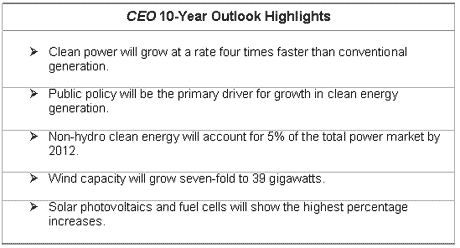
The Drivers
Despite this less than stellar track record, CEO believes the overall outlook for the clean energy market is very bright indeed. Ample anecdotal evidence supports the notion that clean energy is poised for rapid and sustained growth. Large corporations such as DuPont are committing to clean energy procurement goals. Traditional energy companies like BP Amoco, Chevron-Texaco, and Shell are making significant investments in the clean energy business.
Public policy is by far the most important determinant of the future for clean energy. Federal and state initiatives to promote clean energy will create a base demand level. The Energy Bill recently passed by the U.S. Senate includes a national renewable portfolio standard, trading mechanisms, significant tax credits, and other funding mechanisms for clean energy. President Bush also recently announced a $1.5 billion program to commercialize fuel cells. At the state level, renewable portfolio standards and stipulated goals have the potential to create demand for new clean energy capacity of at least 23 gigawatts by 2013 (see Table I).
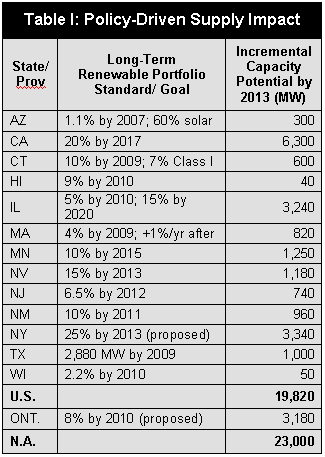
Other factors will also come into play. Advances in clean energy technologies will increase performance and cost-effectiveness. Deregulation of electric utility markets will continue to foster an environment where new technologies and innovation can thrive. Energy security and reliability concerns will increase interest in new clean energy technologies that can be situated strategically throughout a utility grid as an alternative to large central generation. (This article was written prior to the large-scale power blackout.) Reduced reliance on fossil-fuel technologies also factors into the energy security equation.
The Numbers
CEO's base case outlook projects generation from non-hydroelectric renewable energy sources to make up an increasing share of overall North American power generation over the next decade -- increasing from 2.1% to approximately 5.0%. By the end of 2012, clean energy capacity will total 60 gigawatts and will be sufficient to meet forecast demand created by state, provincial, and federal government mandates (Figure I shows the incremental capacity additions over the next ten years).
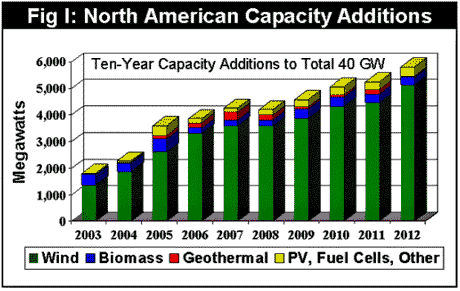
Following are brief commentaries on each key sector (see Figure II for supply outlook by sector):
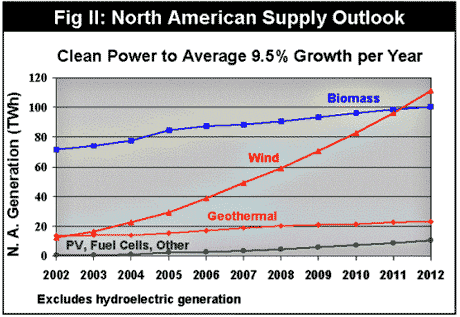
Wind: Wind power is becoming increasingly “mainstream” in North America as the technology gains market acceptance and large credible players like General Electric and FPL Energy take significant positions in the industry. As public policy creates demand for clean energy, wind will be the technology of choice in many instances simply because a) it has a proven track record, and b) it is the lowest-cost alternative. CEO sees wind power growing dramatically over the next ten years, with installed capacity increasing at an average annual rate of 22%. By 2012, wind power is forecast to reach 39 gigawatts and account for two-thirds of all non-hydro renewable power supplies in North America. An important caveat to this base case forecast is that it is highly predicated on aggressive U.S. federal policies and incentives to promote renewable energy. CEO believes that is in fact the most likely scenario.
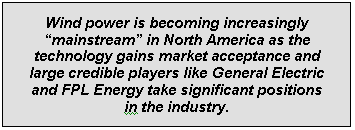
Biomass: This sector, which includes co-firing, gasification, and municipal solid waste, is forecast to grow at a steady but modest rate of approximately 2.7%. Much of this growth will come from the addition of landfill gas recovery and on-site combined heat and power applications.
Geothermal: Geothermal generation is likely to get a significant boost over the next several years from U.S. federal tax incentives and easing of restrictions on leasing federal lands. North American installed capacity is expected to increase by 50% by the end of the decade to approximately 4.0 GW. This figure represents a small fraction of the estimated 25 GW of geothermal resources that can be tapped in the western U.S. and Canada. There is room for additional growth from this base case depending on how pending provisions of the U.S. energy bill pan out in coming weeks.
Solar PV: Solar technologies overall are not expected to make significant contributions to U.S. grid-connected electricity supplies. However, installations of solar photovoltaics at end user sites are projected to grow dramatically – at an average annual rate of 30% over the next ten years. The primary driver for this market is cost. This forecast assumes: a) manufacturers will continue to make strides in reducing costs of producing PV panels, b) cost of grid power will steadily increase over the next ten years, and c) state and federal incentives will continue.
Fuel Cells: This sector is a wild card. CEO sees fuel cells as one of the most promising power generation technologies on the horizon. However, the timing of when fuel cells will break through to the broad commercial marketplace is difficult to predict. The industry faces two major challenges: cost reduction and proven performance. We believe much progress will be made on both fronts in the next ten years and result in an increase in installed capacity from a few megawatts to 470 megawatts by 2012. Most of this new capacity will be deployed at commercial, industrial, and institutional facilities as well as at utility substations in size ranges of 50 kilowatts to 50 megawatts. Major automobile manufacturers will play a significant role, either directly or indirectly, as their backing of stationary fuel cell projects will help their endeavors in the vehicular marketplace. Again, public policy will factor prominently into the outlook for this sector. If significant public funding is made available for stationary applications, fuel cells could achieve commercialization much sooner.
CEO’s long-term view of the clean energy sector is based on current affairs, present and proposed projects, technology advancements, and governmental policies and trends. As everyone eagerly awaits the final results on the energy bill in Washington, the outlook remains bright for clean energy.
The forgoing article was presented in the August issue of Clean Energy Outlook, a monthly publication focused on commercial implications of news, technologies, and projects within the clean energy industry.
Readers Comments
| Date | Comment |
| Energy Central
Member 2.28.04 |
I'd be interested
to see a 10 year plan of environment concern and
consequent action expressed in comparison to the
migration of the prestigious companies named to
less environmentally-restrictive challenging regions
of the world.
Safety costs money and it is globally accepted that Fortune 500 league migration to SE Asia, Latin America etc is primarily based up the less stringent safety requirements in-place within those donor countries. (It would be too vulgar to mention the cheap labor costs drivers). However, recently Environment seems to have vastly out-ridden Safety in terms of the auxiliary costs for the provision of these niceties. And, although the World Bank has tentatively implemented EIA strategies, hoping to rein-in the Fortune 500 rogues, the lure of the Orient is ever increasing. Just look where the latest copper smelter has landed in Thailand’s back-yard… and who owns it. And, Mr World Bank, what happened to the international outcry in respect of it? Many articles, CEO magazine and otherwise, have frankly admitted that the release-control technologies we all placed our bets upon have fallen far short of even the weakest expectations and sadly translating to a problem that won’t go away. So, what do we do? We push it away. Ironically it doesn’t go away, it just moves… or should we say we just move it out of our own back-yard: and our jobs with it.
|
Email this page to a friend
If you speak another language fluently and you liked this page, make
a contribution by translating
it! For additional translations check out FreeTranslation.com
(Voor vertaling van Engels tot Nederlands)
(For oversettelse fra Engelsk til Norsk)
(Для дополнительных
переводов проверяют
FreeTranslation.com )


